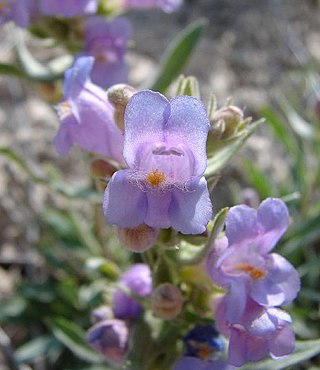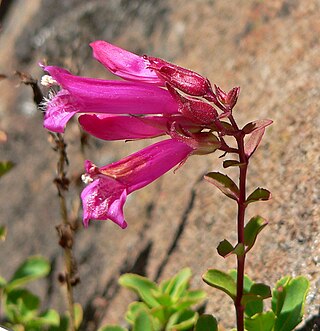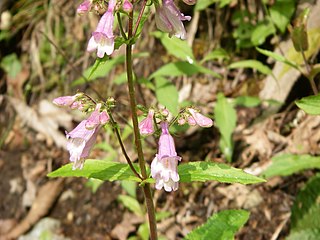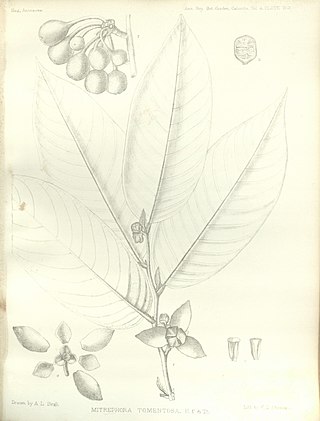
Penstemon digitalis is a species of flowering plant in the plantain family, Plantaginaceae. The flowers are white and are borne in summer. It is native to eastern Canada and the eastern and southeastern United States. Penstemon digitalis is the most widespread species of Penstemon east of the Mississippi River.

Penstemon albomarginatus is an uncommon species of penstemon known by the common name white-margined beardtongue. It is native to the deserts of southern Nevada and western Arizona, as well as in two desert washes in the Mojave Desert in California. It is a perennial herb with several erect stems emerging from a taproot in the sand, their base buried beneath the surface. The stem branches are hairless and somewhat waxy in texture, reaching up to about 35 centimeters tall. The oppositely arranged leaves are oblong or widely lance-shaped, pale green edged in white, and up to 5 centimeters long. The inflorescence produces several purplish-pink tubular flowers between 1 and 2 centimeters long surrounded at the bases by toothed, white-edged sepals. The flower has some hairs in the mouth, but the staminode is hairless. The flowers are pollinated by vespid wasps and probably other insects, such as carabid beetles.

Penstemon anguineus is a species of penstemon known by the common name Siskiyou beardtongue. It is native to the mountains of Oregon and northern California, where it grows in coniferous forests, often in open areas left by logging operations. It is a perennial herb reaching up to about 90 centimeters in maximum height. The oppositely arranged leaves are lance-shaped to oval, the ones higher on the plant clasping the stem. The inflorescence produces several light blue or purple flowers between 1 and 2 centimeters long. The sepals and flowers are coated in glandular hairs. The inside of the flower has many long hairs and the staminode has a sparse hair coating.
Penstemon caesius is a species of penstemon known by the common name San Bernardino beardtongue. It is endemic to California, where it is known from the San Bernardino and San Gabriel Mountains, as well as the southern mountains of the Sierra Nevada. It is a member of the flora on rocky slopes and in coniferous forests and alpine habitat in the mountains. It is a perennial herb with erect branches up to about 80 centimeters in maximum height. The lower branches may be woody, the upper hairless and waxy, and the inflorescence glandular. Most of the leaves are basal on the plant, rounded or oval, and up to about 4 centimeters long. The inflorescence produces purple-blue tubular flowers roughly 2 centimeters long. The flower has a glandular outer surface, a coat of hairs inside, and a hairless staminode. The flowers of this penstemon are pollinated by bees of genus Osmia, which feed on their nectar.
Penstemon calcareus is a species of penstemon known by the common name limestone beardtongue. It is native to California, where it is known from the deserts of central San Bernardino County, as well as the Death Valley area, where its distribution extends just over the border into Nevada. It grows in scrub and woodland, often on limestone substrates. It is a perennial herb with erect branches up to about 25 centimeters in maximum height, grayish with a coating of fine hairs. The toothed, lance-shaped leaves are up to 6 centimeters long. The inflorescence produces bright pink to purplish tubular or funnel-shaped flowers between 1 and 2 centimeters long. The flower has a glandular outer surface and a staminode coated with yellow hairs.
Penstemon cinicola is a species of penstemon known by the common name ash penstemon. It is native to northeastern California and southern Oregon, where it grows in forests and plateau habitat. It is a perennial herb with upright branches 40 centimeters (16 in) maximum height. The leaves are 3 to 6 centimeters long, linear in shape, folded lengthwise, and curved backwards. The inflorescence produces tubular flowers with wide lipped mouths. The flower is blue-purple in color, just under one centimeter long, and hairless except for hairs on the floor of the mouth and on the staminode.

Penstemon gracilentus is a species of penstemon known by the common names slender beardtongue and slender penstemon. It is native to the mountains and sagebrush plateau of northeastern California, western Nevada, and southern Oregon, where it grows in forest, woodland, and scrub habitat. It is a perennial herb producing upright branches to about 65 centimeters in maximum height, the stems developing woody bases. The leaves are up to 10 centimeters in length and linear or lance-shaped. The glandular inflorescence produces several tubular purple flowers up to 2 centimeters long. The mouth of each flower may be hairless or coated in long hairs, and the staminode usually has a coat of yellow hairs.

Penstemon heterodoxus is a species of penstemon known by the common name Sierra beardtongue. It is native to California and western Nevada where it grows in several of the mountain ranges from the Klamath Mountains to the Sierra Nevada - and the slopes and plateaus to the east. It grows in subalpine and alpine climates in mountain forests, meadows and talus.

Penstemon janishiae is a species of penstemon known by the common names Antelope Valley beardtongue and Janish's beardtongue. It is native to the northwestern United States in sections of Idaho, Oregon, Nevada and northwestern California, where it is a member of the flora in sagebrush, woodland, and pine forests. It is a perennial herb with several hairy upright stems reaching up to about 25 centimeters tall. The leaves are up to 6 centimeters long, many located around the base of the plant and several pairs along each stem. The inflorescence produces several wide-mouthed tubular flowers 2 to 3 centimeters long. Each hairy, glandular flower is pale purple to pinkish or bluish in color with a dark-lined, pouchlike throat. The mouth of the flower is hairy and the protruding staminode is coated in bright orange or yellow hairs.

Penstemon monoensis is a species of penstemon known by the common name Mono penstemon. It is endemic to the White and Inyo Mountains of eastern California, where it grows in scrub, woodland, and sandy washes. It is a perennial herb growing erect to about 30 centimeters tall, gray-green in color from a dense coating of light hairs. The paired leaves are lance-shaped, sometimes toothed or wavy along the edges and up to 12 centimeters long. The glandular inflorescence bears cylindrical or funnel-shaped flowers in shades of bright to deep pink, measuring around 2 centimeters in length. The mouth of the flower may have a white or pale area on the floor with a patch of hairs, and the staminode is usually hairy.

Penstemon newberryi is a species of penstemon known by the common name mountain pride or Newberry's penstemon. It is native to the mountains of northern California, Oregon, and Nevada, where it grows in rocky habitat, often at high elevation, such as talus. It is a bushy, mat-forming subshrub growing up to 30 centimeters tall. The leaves are mostly basal on the plant, oblong or oval and toothed, measuring 1 to 4 centimeters in length, with a few smaller pairs along the stem. The glandular inflorescence bears showy magenta flowers 2 to over 3 centimeters in length. The flower is generally tubular or funnel-shaped and has a coating of short to long and curly hairs in the mouth and on the staminode.
Penstemon personatus is an uncommon species of penstemon known by the common name closethroat beardtongue.

Penstemon pseudospectabilis a species of penstemon. It's native to the southwestern United States, where it grows in desert and plateau habitat types, such as sandy washes, scrub, and woodland. The plant is generally a shrub growing to one meter, with many erect stems. The thin leaves are oval with wide, pointed tips and serrated edges. They are arranged oppositely in pairs, many are completely fused at the bases about the stem, forming a disc. The inflorescence bears tubular flowers with expanded, lobed mouths and glandular hairs on most surfaces, except the hairless staminode. The flower grows to 2.5 centimeters and is reddish pink.

Penstemon tracyi is a rare species of penstemon known by the common names Trinity penstemon and Tracy's beardtongue.

Penstemon canescens is a species of penstemon in the family Plantaginaceae. P. canescens is known by the common names Eastern gray beardtongue or Appalachian beardtongue. It is native to woodlands, forest edges, and roadsides of the southeastern United States and flowers May through July. It is a perennial herb producing stems reaching one meter in maximum height. Penstemon canescens has been used by Native Americans for thousands of years.

Penstemon davidsonii is a species of penstemon known by the common name Davidson's penstemon, honoring Dr. George Davidson. It is native to North America from the Sierra Nevada Range in California and Nevada through the Coast and Cascade ranges of Oregon and Washington into British Columbia.

Mitrephora tomentosa is a species of plant in the family Annonaceae. It is native to Bangladesh, Cambodia, Laos, Myanmar, Thailand, and Vietnam. Joseph Hooker and Thomas Thomson, the British botanists who first formally described the species, named it after the dense covering of hair on its young branches, leaves and flowers.

Penstemon albidus, commonly known as white penstemon, white-flower beardtongue, or Red-Line Beardtongue is a very widespread perennial flower of the mixed-grass and shortgrass prairies. Its natural distribution is from Manitoba and Alberta in Canada to Texas and New Mexico in the United States. The bright white flowers for which they are named are quite attractive to both bees and hummingbird moths.

Penstemon secundiflorus, commonly known as sidebells penstemon, or orchid beardtoungue is a species of Penstemon that grows in dry forests, high plains, and scrub lands from Wyoming to Mexico. It is a herbaceous perennial plant that typically grows to a height of 20 to 50 cm and has narrow, lance-shaped leaves that are grayish-green in color. The flowers of the sidebells penstemon are tubular in shape and are arranged in a one-sided spike, with the blooms all facing the same direction, and for this reason was named "secundiflorus", which means "one-sided flowers". The flowers are most often delicate shades of orchid or lavender. It is sometimes used in xeriscaping, rock gardens, and wildflower meadows, and is well-suited to dry, sunny locations with well-drained soil.

Penstemon auriberbis, commonly known as the Colorado penstemon or Colorado beardtounge is a species of Penstemon that grows in the shortgrass prairies of southern Colorado and in a few places in northern New Mexico. Although specimens were collected on the 1820 expedition by Stephen H. Long through the area, they were not scientifically described as a separate species until 1920.

















